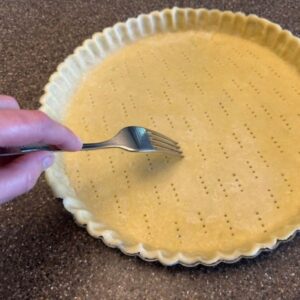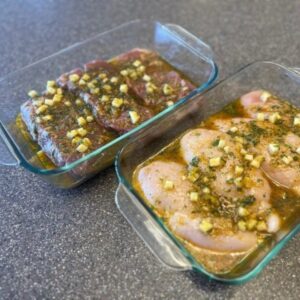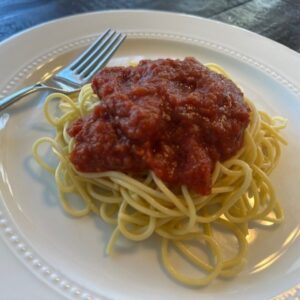Have you tried making quick pizza doughs at home that yield less than desirable results? The trick behind making true, artisan pizza dough isn't simply just using better ingredients (although that makes a difference!) but also investing time to the craft through a process known as cold fermentation. Allowing the prepared dough several days to rest under refrigeration will create an easier dough to work with, yielding a crispier, perfectly browned crust (with foldability!) and a more developed flavor. Start the process of making artisan pizza dough several days ahead of pizza night, with a dedicated 2-½ hours the first day, and just 30 minutes of intermittent, hands-on time. Your refrigerator will do the majority of the work on those non-active days.
I'm a huge fan of King Arthur brand flours, and using their high gluten artisan bread flour, which has a higher protein ratio of 14%, as compared to, say, a typical All-Purpose Flour (which has anywhere from 10-12%) really makes a difference in the structure of the crust. Another key ingredient you may not be familiar with is non- (or low) diastatic malt powder, which is commonly used in making bread products to help support a taller rise, a crispier, more browned exterior (think soft pretzels!) and an overall, more delicious flavor.

INGREDIENTS
- 600 g High Gluten, Artisan Bread Flour (Appx. 5 Cups*), plus a little extra for dusting
- 6 g Non (or Low) Diastatic Malt Powder (Appx. 1-½ tsp.)
- 100 g Warm Water (105-110℉) (Appx. just shy of ½ C.)
- 3 g Active Dry Yeast (about 1 tsp.)
- 12 g Pizza Dough Flavor optional
- 308 g Ice Water, divided 88 g (6 Tbsp.) separated
- 12 g Fine Sea Salt (Scant 2 tsp.)
- 12 g Extra Virgin Olive Oil (Appx. 1 Tbsp)
INSTRUCTIONS
Before you begin, take a look at the following chart as a reference for timing out your dough-making process. This is just a guideline. Regardless of whether you start with a 24-hour (A) or a 36-hour (B) refrigeration on Day 2 (or anywhere in between, but no longer), you can determine when your pizza dough will be ready for baking, based on whether you choose a 12, 24, 36 or 48-hour second refrigerated rise. Just follow the (A) or (B) under that window.
For example, if you begin making dough on a Tuesday morning at 8:00am, allowing your dough to rise for 36 hours under refrigeration through Day 2, you'll follow timeline (B), starting on Wednesday at 10:30pm. If you allow your dough a second, 36-hour refrigeration, your pizza dough will be ready to go by Friday at 10:30am.

Day One:
Total Time: 2 hours and 30 Minutes (Active Hands-On Time: 30 Minutes)
Step 1: Gather all of your ingredients, along with a kitchen scale (or measuring cups and spoons), as well as a large mixing bowl, and a stand mixer fitted with the dough hook attachment.

Step 2: In a mixing bowl set over the kitchen scale set to grams, tare the bowl to zero (so that you are only measuring the weight of the actual ingredients and not the bowl itself). Measure out 600 grams of high gluten, artisan bread flour (my favorite is from King Arthur). If you are using measuring cups, you'll want to use the 'spoon and sweep method' (see notes below) and measure out 5 cups of flour. Directly to the flour, add 6 grams of non-diastatic malt powder (about 1-½ tsp, if not measuring by weight). Lastly, add 12 grams of King Arthur Pizza Dough flavor, which is completely optional, but an absolutely delicious addition to your dough. Set your flour mixture aside.




Step 3: In a glass, liquid measuring cup or small bowl over the scale, weigh 100 grams of very warm water (somewhere between 110-115℉, hot but not scalding), then add in your 3 grams of active dry yeast. If not measuring by weight, the water should come to just below the ½ C mark on the liquid measuring cup, and the yeast will be about 1 tsp. Give the yeast a good mix, and set aside, allowing the yeast to dissolve, about one minute. Small bubbles should begin to form.

Step 4: If you haven't done so already, pour ice and water into a large liquid measuring cup, and set a second liquid measuring cup onto the kitchen scale. Measure 308 grams of the water, not including the ice, which comes just shy of 1 cup. From this, portion out 6 Tablespoons (about 88 grams) into a small, separate bowl, and set aside.

Step 5: Into the bowl of your stand mixer, pour the 220 grams of ice water (308 g less the reserved 88 g) and add the flour mixture. On the lowest speed (setting 1), begin working the dough, just until it barely comes together, about 1 minute. The texture will be crumbly and very sticky.



Step 6: Increase the speed to setting 2 and carefully add in the warm yeast mixture. Mix for a full minute.

Step 7: Drizzle in the reserved cold water, maintaining the speed at setting 2. Continue working the dough for another minute and then turn off the mixer.
Step 8: Measure 12 grams of fine sea salt (a scant 2 tsp) and shake over the dough. Turn the mixer onto an increased speed, setting 3 and then 4, and run for about 2 minutes to ensure that the salt has fully been incorporated.
Step 9: Decrease the speed down to setting 2 and carefully drizzle in 12 grams of extra virgin olive oil (about 1 Tbsp.) while the mixer is running and then increase the speed to high (setting 8). Run the mixer for 3 minutes.

Step 10: Lightly dust a clean work surface with a little extra of the flour. Using a flexible bench scraper, move the dough from the kitchen aid bowl and place onto the prepared surface. The dough will be sticky.

Step 11: Using your hands, pull on the top of the dough to stretch. Fold the top over the length of the ball, pressing to seal, then, stretching from the bottom, pull up and press over the top fold. Rotate and repeat.

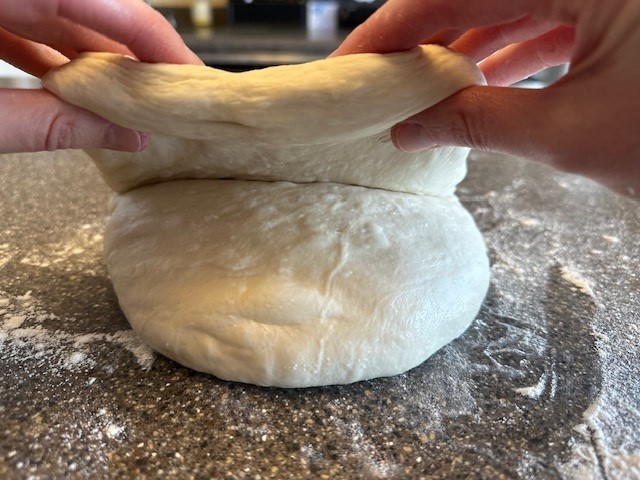
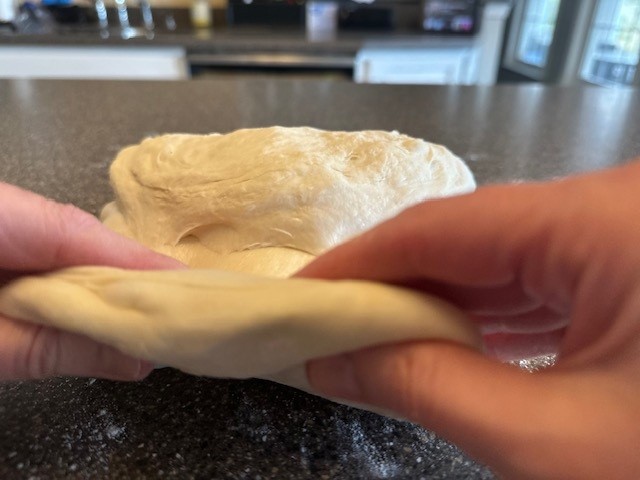
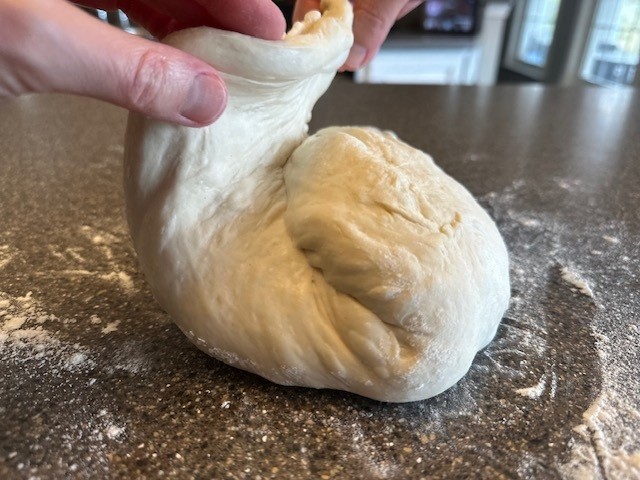
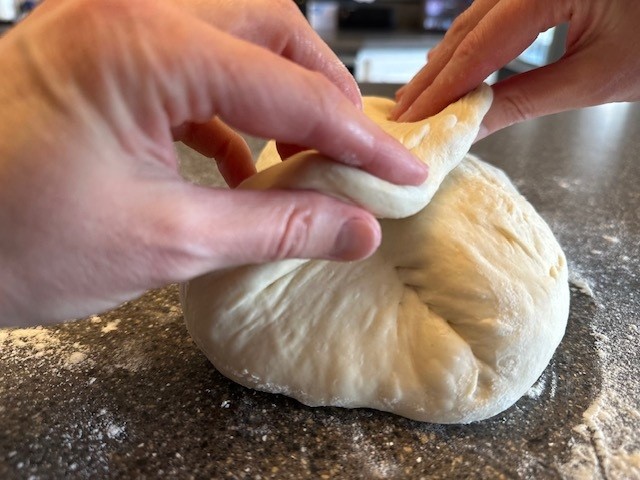
Step 12: From here, flip the dough over, folded seam-side down, and scoop the dough into your hands, stretching the surface as you tuck in from the bottom in towards the palms, rotating the ball of dough continuously as you go. This will create a smooth, round shape.

Step 13: Place the ball of dough into a lightly greased bowl and cover tightly with plastic wrap. Set at room temperature for one hour, allowing the dough to double in size.
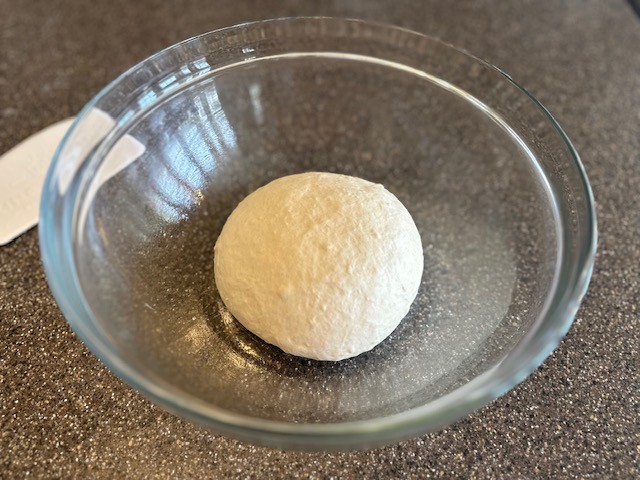
Step 14: After the first hour-long rise, you'll need to repeat the steps of folding and shaping the dough four (4) additional times, with a rest period of 30-minutes at room temperature in between, so plan the next two hours accordingly. Keep a little bit of flour handy to prep your work surface just beforehand each time. (See Step 11 for reference)
Step 15: When your dough has completed its additional 2 hours of resting, you'll want to move the dough to an airtight container (or a medium sized bowl covered tightly with plastic wrap) and place into the refrigerator for a minimum of 24 hours but ideally, up to 36 hours. This will allow the structure and the flavor of the dough to develop.

Day One-Day Two
Total Time: 24-36 hours inactive time, plus (Active Hands-On Time: 15 minutes, to mix and divide the dough before storing for the second phase of the cold fermentation)
No action is needed during this rest period. Your dough will remain in the refrigerator between 24 and 36 hours, or anytime in between. The longer the dough sits, the better the quality and flavor of the final product, but it is best not to extend this first fermentation stage longer than 36 hours.
Step 1: After your first cold fermentation stage, remove the dough from refrigeration and place directly into the bowl of the stand mixer fitted with the dough attachment. Mix the dough on the slowest setting for about 30 seconds, just to gently work the dough and release the air bubbles. Remove the dough from the mixing bowl and place onto a clean, lightly floured work surface.

Step 2: Weigh the mixed dough on your kitchen scale (it should be approximately 1045 grams, give or take a few grams). Divide that amount by 4, and this should be the weight, in grams, for each ball of dough you will portion out. If you are not using a kitchen scale, do your best to divide the dough as evenly as possible.

Chef Note: An average 12" pizza, about the size that most home ovens can accommodate, should weigh about 250 grams.
For this recipe, my dough weighed 1042 grams. 1042 g / 4 = 260.5 g, so I portioned each of my dough balls to weigh 260 g. For reference, 15 grams is equivalent to about a tablespoon, so the difference in grams here is insignificant.

Step 3: Place the portioned dough into a lightly oiled container with a tight-fitting lid, or onto a baking sheet covered tightly with plastic wrap. Return to the refrigerator for a minimum of 24 hours but up to 48 hours.

Days Two-Four
So long as you've waited at least 24 hours from when you placed your portioned pizza dough into the refrigerator, you're all set to begin making pizza. Otherwise, feel free to keep it refrigerated up to 48 hours.
Chefs Note: When you're ready to make pizza, you'll want to roll COLD dough out on a clean work surface dusted lightly with flour, using a rolling pin. (More detailed instruction on stretching dough by hand will be found in pizza recipe posts). The cold dough, straight out of the refrigerator, will actually be much more pliable and easier to work with then if you allow the dough to come to room temperature.
If not using all the dough, place any unused portions onto a parchment lined baking sheet dusted lightly with flour and covered the top lightly with plastic wrap. Pop into the freezer for about 30 minutes, just until the dough is firm to the touch, not frozen. Wrap each individual portion of dough tightly in plastic wrap, and place wrapped portions into a Ziploc freezer bag. To use later, allow the dough to thaw in the refrigerator first, and then allow about 30 minutes (or up to an hour) at room temperature before baking.
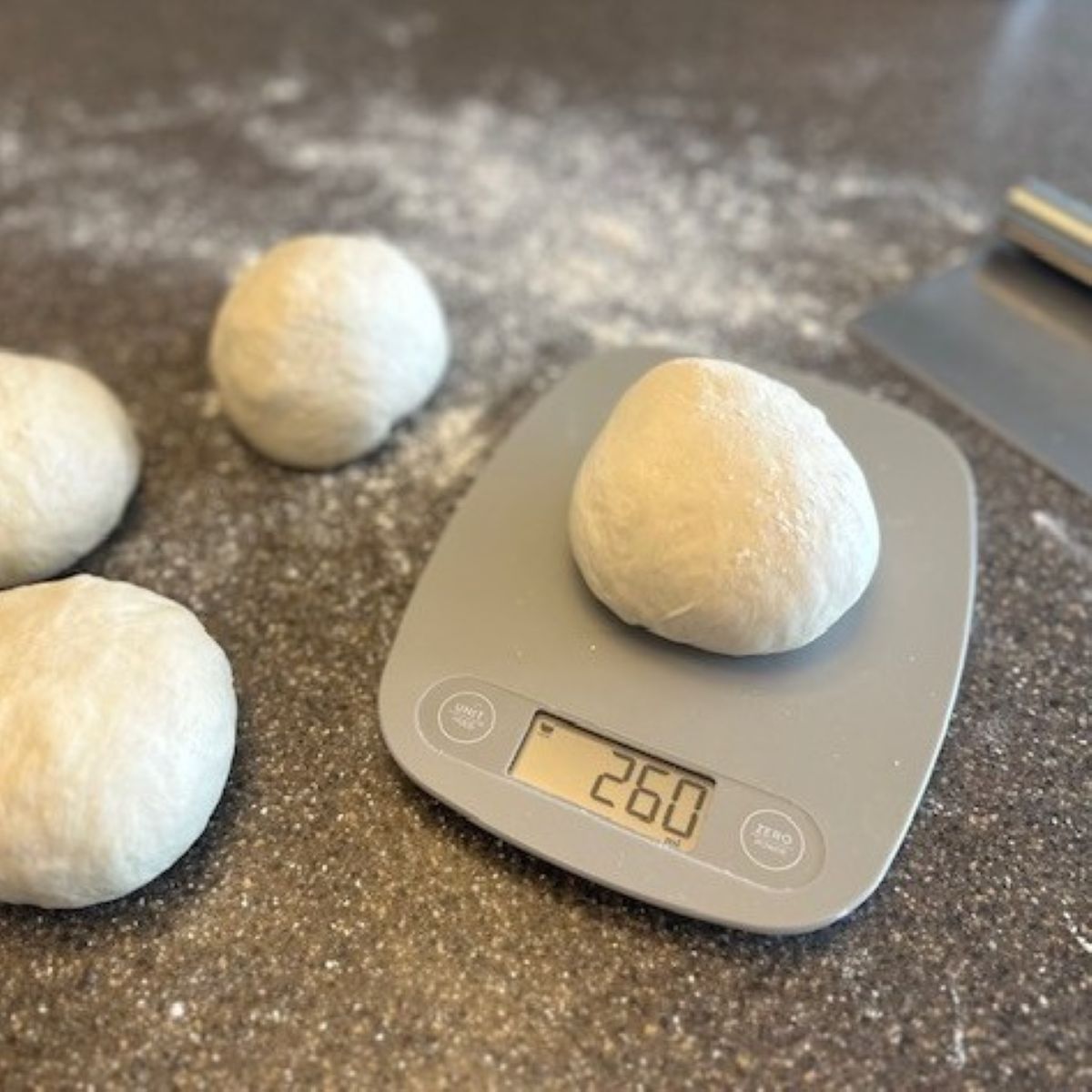
Artisan Pizza Dough
Equipment
- Digital Kitchen Scale or measuring cups and spoons
- Glass Liquid Measuring Cups
- KitchenAid Stand Mixer with dough hook attachment
- Flexible Bench Scraper
- Stainless Bench Scraper
- Large Mixing Bowl
- Medium and small mixing bowl
- Wire Whisk
- Airtight Container
- Plastic Wrap
- Container with Tight-Fitting Lid or a sheet pan with plastic wrap
Ingredients
- 600 g High Gluten, Artisan Bread Flour (Appx. 5 Cups*), plus a little extra for dusting
- 6 g Non (or Low) Diastatic Malt Powder (Appx. 1-½ tsp.)
- 100 g Warm Water (105-110℉) (Appx. just shy of ½ C.)
- 3 g Active Dry Yeast (about 1 tsp.)
- 12 g Pizza Dough Flavor optional
- 308 g Ice Water, Divided 88 g (6 Tbsp.) separated
- 12 g Fine Sea Salt (Scant 2 tsp.)
- 12 g Extra Virgin Olive Oil (Appx. 1 Tbsp)
Instructions
Day 1
- Gather all of your ingredients, along with a kitchen scale (or measuring cups and spoons), as well as a large bowl, and a stand mixer fitted with the dough hook attachment.
- In a mixing bowl set over the scale, set to grams, and tare the bowl to zero (so that you are only measuring the weight of the actual ingredients and not the bowl itself). Measure out 600 grams of high gluten, artisan bread flour (my favorite is from King Arthur). If you are using measuring cups, you'll want to use the 'spoon and sweep method' (see notes below) and measure out 5 cups of flour. Directly to the flour, add 6 grams of non-diastatic malt powder (about 1-½ tsp, if not measuring by weight). Lastly, add 12 grams of King Arthur Pizza Dough flavor, which is completely optional, but an absolutely delicious addition to your dough. Set your flour mixture aside.
- In a glass, liquid measuring cup or small bowl over the scale, weigh 100 grams of very warm water (somewhere between 110-115℉, hot but not scalding), then add in your 3 grams of active dry yeast. If not measuring by weight, the water should come to just below the ½ C mark on the liquid measuring cup, and the yeast will be about 1 tsp. Give the yeast a good mix, and set aside, allowing the yeast to dissolve, about one minute. Small bubbles should begin to form.
- If you haven't done so already, pour ice and water into a large liquid measuring cup, and set a second liquid measuring cup onto the kitchen scale. Measure 308 grams of the water, not including the ice, which comes just shy of 1 cup. From this, portion out 6 Tablespoons (about 88 grams) into a small, separate bowl, and set aside.
- Into the bowl of your stand mixer, pour the 220 grams of ice water (308 g less the reserved 88 g) and add the flour mixture. On the lowest speed (setting 1), begin working the dough, just until it barely comes together, about 1 minute. The texture will be crumbly and very sticky.
- Increase the speed to setting 2 and carefully add in the warm yeast mixture. Mix for a full minute.
- Drizzle in the reserved cold water, maintaining the speed at setting 2. Continue working the dough for another minute and then turn off the mixer.
- Measure 12 grams of fine sea salt (a scant 2 tsp) and shake over the dough. Turn the mixer onto an increased speed, setting 3 and then 4, and run for about 2 minutes to ensure that the salt has fully been incorporated.
- Decrease the speed down to setting 2 and carefully drizzle in 12 grams of extra virgin olive oil (about 1 Tbsp.) while the mixer is running and then increase the speed to high (setting 8). Run the mixer for 3 minutes.
- Lightly dust a clean work surface with a little extra of the flour. Using a flexible bench scraper, move the dough from the kitchen aid bowl and place onto the prepared surface. The dough will be sticky.
- Using your hands, pull on the top of the dough to stretch. Fold the top over the length of the ball, pressing to seal, then, stretching from the bottom, pull up and press over the top fold. Rotate and repeat.
- From here, flip the dough over, folded seam-side down, and scoop the dough into your hands, stretching the surface as you tuck in from the bottom in towards the palms, rotating continuously as you go. This will create a smooth, round shape.
- Place the ball of dough into a lightly greased bowl and cover tightly with plastic wrap. Set at room temperature for one hour, allowing the dough to double in size.
- After the first hour-long rise, you'll need to repeat the steps of folding over and shaping the dough four (4) additional times, with a rest period of 30-minutes at room temperature in between, so plan the next two hours accordingly. Keep a little bit of flour handy to prep your work surface just beforehand. (See Step 11 for reference)
- When your dough has completed its additional 2 hours of resting, you'll want to move the dough to an airtight container (or a medium sized bowl covered tightly with plastic wrap) and place into the refrigerator for a minimum of 24 hours but ideally, up to 36 hours. This will allow the structure and the flavor of the dough to develop.
Day 2
- Your dough is resting in the refrigerator between 24 and 36 hours. The longer the dough sits, the better the quality and flavor of the final product but is best if not left longer than 36 hours.
Day 2, After 24-36 hours
- Remove the dough from refrigeration and place into the bowl of the stand mixer fitted with the dough attachment. Mix the dough on the slowest setting for about 30 seconds, just to gently work the dough and release the air bubbles. Remove the dough from the mixing bowl and place onto a clean, lightly floured work surface.
- Weigh the mixed dough on your kitchen scale (it should be approximately 1045 grams, give or take a few grams). Divide that amount by 4, and this should be the weight, in grams, for each ball of dough you will portion out. If you are not using a kitchen scale, do your best to divide the dough as evenly as possible. Chefs Note: An average 12" pizza, about the size that most home ovens can accommodate, should weigh about 250 grams. For this recipe, my dough weighed 1042 grams. 1042 g / 4 = 260.5 g, so I portioned each of my dough balls to weigh 260 g. For reference, 15 grams is equivalent to only about a Tablespoon, so the difference in grams here is insignificant.
- Place the portioned dough into a lightly oiled container with a tight-fitting lid, or onto a baking sheet covered tightly with plastic wrap. Return to the refrigerator for a minimum of 24 hours but up to 48 hours.
Day 3 or 4 (After a minimum of 12 hours but up to 48 hours)
- So long as you've waited at least 12 hours from when you placed your portioned pizza dough into the refrigerator, you're all set to begin making pizza. Otherwise, feel free to keep it refrigerated up to 48 hours, keeping in mind that the longer the cold fermentation process, the better the overall dough.Chefs Note: When you're ready to make pizza, you'll want to roll COLD dough out on a clean work surface dusted lightly with flour, using a rolling pin. (More detailed instruction on stretching dough by hand will be found in pizza recipe posts). The cold dough, straight out of the refrigerator, will actually be much more pliable and easier to work with then if you allow the dough to come to room temperature. If not using all the dough, place any unused portions onto a parchment lined baking sheet dusted lightly with flour and covered the top lightly with plastic wrap. Pop into the freezer for about 30 minutes, just until the dough is firm to the touch, not frozen. Wrap each individual portion of dough tightly in plastic wrap, and place wrapped portions into a Ziploc freezer bag. To use later, allow the dough to thaw in the refrigerator first, and then allow about 30 minutes (or up to an hour) at room temperature before baking.
